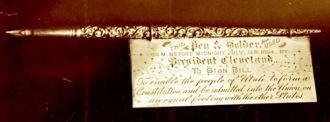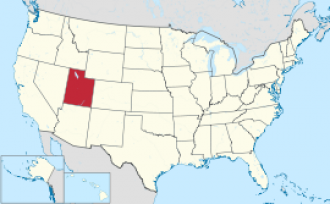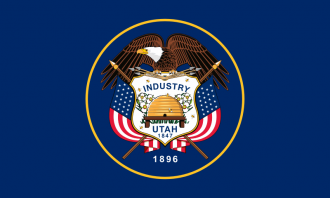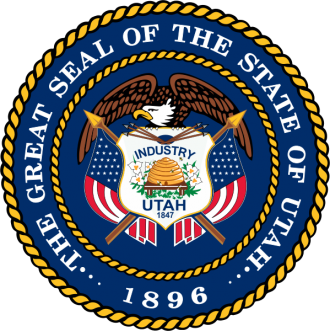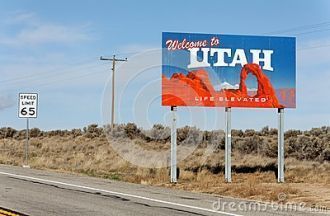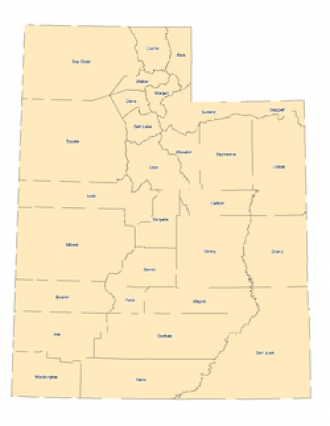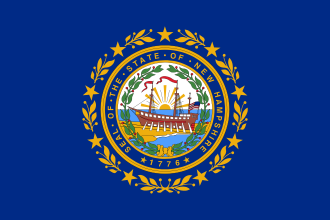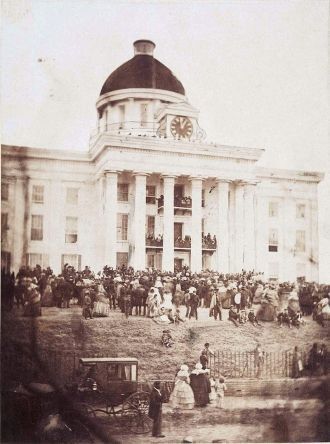USA
First & Second Attempt
Utah’s long quest for statehood was finally officially granted in 1896. It was a long struggle for Utah’s Mormons to convince the U.S. federal government that their territory should be admitted to statehood. From the first attempt at statehood in 1849-50, the major point of contention was the Mormon’s embrace of polygamy. The Mormons’ second attempt at statehood, was simultaneous with the Republican Party’s first presidential campaign in 1856. Republican opposition to polygamy was akin to its opposition to slavery; both were condemned in the party platform as the “twin relics of barbarism.” According to recent historical scholarship the number one reason that it took Utah nearly fifty years to be admitted to the Union was because of the practice of polygamy. As historian Joan Smith Iversen writes, “Whereas Mormon historians once held that polygamy was only a diversionary issue raised by anti-Mormons who really opposed the power of the LDS church, recent interpretations by [Edward Leo] Lyman and historian Jan Shipps have found the polygamy issue to be critical to the anti-Mormon struggles.” (Iversen, 585)
In 1850, Congress refused the first request for statehood for a prosposed state named Deseret based on the lack of the requisite number of eligible voters and the huge size of the state. Instead, President Millard Fillmore signed into law on September 9, 1850 the bill creating the Utah Territory with a new border, an initial step on the path to statehood. Damaging the prospects of the Mormons was the admission after repeated denials that one of the church’s religious principles was patriarchal (plural) marriage. It was disclosed that leading male members of the church were encouraged to marry more than one wife. The announcement elicited a negative response from the general American public, and political opposition from the federal government to all Mormon requests for Utah statehood. The government made it known to the Mormons that as long polygamy was condoned and practiced in Utah, statehood would not be granted.
Third & Forth Attempt
The Federal government also took steps to force the Mormons to abandon polygamy. In 1862 during the third failed attempt for statehood Congress was considering legislation to prohibit plural marriage. The Morrill Anti-bigamy Act banned polygamy and dissolved the Mormon Church. It was never effectively enforced, but Congress refused to grant an 1867 request to repeal it.
In 1872 there was a forth attempt at statehood that included a ratified constitution presented to Congress. The Mormon majority was still insisting on calling the new state Deseret, even after the area was named the Utah territory. Congress again said no.
The anti-polygamy crusade heated up. In 1874 Congress passed the Poland Act, which established district courts in Utah, making it easier to prosecute polygamists. In 1879 in the Supreme Court case Reynolds v. United States, Chief Justice Waite ruled that Mormon polygamy was “disruptive of peace and good order, threatening the foundations of the country,” therefore upholding the Morrill Act. Iversen, 588 However, the crusade did not stop there. The Anti-Polygamy Society of Salt Lake City was established a year later in April 1880, when the women members of the group sent a petition to first lady Lucy Hayes requesting help to save the wives of polygamist husbands. The group, which changed its name in August 1880 to the Woman’s National Anti-Polygamy Society, pressed Congress to unseat polygamist George Q. Cannon, Utah’s territorial representative to Congress.
Fifth Attempt
In 1882 a mixed Mormon and non-Mormon constitutional convention requested for the fifth time that Utah be admitted as a state. This time the proposed constitution established Utah as “a republican form of government” and adopted the use of the name “Utah.” Congress again refused. As Larson writes, “Utah would not be admitted without complete divorcement of church and state and abolition of plural marriage.” Poll, 258 In 1882 a law was passed criminalizing polygamy.
Sixth Attempt
When the Democrat Grover Cleveland was elected President, the Mormons hoped that statehood could finally be pushed through, since the Democrats had always been more supportive, while the Republicans pushed for anti-polygamy legislation. But two years later the U.S. Senate passed the Edmunds-Tucker bill, which would force the LDS Church to forfeit property in excess of $50,000, and would abolish woman’s suffrage in the territory if polygamy continued. In February 1887, the bill passed both houses and Cleveland allowed it to take effect without his signature.
Still Cleveland tried to ease tensions in the manner in which he filled Utah territorial positions. Church emissaries developed an understanding with the President and some of his closest advisors, including Solicitor General George A. Jenks.
In their sixth attempt at statehood in 1887, the Utahns included a constitutional clause prohibiting polygamy (Jenks wrote it). Mormon Church leaders thought it was better to control the polygamy situation themselves, and believed the constitutional wording was enough of a goodwill gesture. Still, the Church hierarchy would not give up polygamy as a tenet and practice. Congress doubted that the Utah constitutional amendment against polygamy would be enforced, and denied statehood.
The Woodruff Manifesto
The denial showed that the Church had to do something to something to show the Mormons would end polygamist marriages. The Church attempted several goodwill gestures in 1889, first withholding the authority to perform the polygamist marriages and then razing the Endowment House on Temple Square, where many polygamous unions had been performed. This was still not enough; the Church had to make a more formal declaration against the practice, especially after the introduction of the Cullom-Struble Bill, which would have denied the vote even to non-polygamous Mormons. Church representatives sought intervention from the Secretary of State James G. Blaine, who had Republican support from Utah. According to Larson and Poll, Blaine “promise[ed] to halt congressional action on Mormon disfranchisement if the church ‘got into line.’ ” Poll, 388 He held off the passage of the bill as long as the Church would ban polygamy.
The backlash from Washington forced the President of the Mormon Church, Wilford Woodruff, to finally relent. The official proclamation, known as the Woodruff Manifesto (September 24, 1890), declared that Endowment House had been razed and denied that polygamous marriages had been performed in 1889. The manifesto concluded, “and now, I publicly declare that my advice to the Latter-day Saints is to refrain from conducting any marriage forbidden by the law of the land.” (Poll, 372)
The Secretary of the Interior, John W. Noble, did not accept the manifesto as authoritative “without its acceptance by the [church] conference.” On October 6, 1890, the Mormons gathered and unanimously approved the manifesto. The historian Howard R. Lamar has called the move “the policy of superior virtue and patriotic conformity.” (Poll, 387) Washington remained cautious about the manifesto, and President Benjamin Harrison still did not believe Utah should be admitted as a state. But the church’s action finally persuaded the territorial governor, a zealous anti-polygamy crusader, that Utah deserved statehood.
The Home Stretch
There remained one issue that Washington wanted resolved before Utah’s petition could be accepted; the people had to establish branches of the two national political parties. Until that point the political parties were aligned with religious beliefs; the Peoples party was Mormon; the Liberal party was non-Mormon. The system blurred the division of state and church that characterized the American political system, and was the last barrier to statehood. As the historians Gustive O. Larson and Richard D. Poll write: “As long as the People’s Party functioned as the political arm of the Mormon Church, the church-state struggle was certain to continue, with the Liberal Party blocking every approach to membership in the Union. With the ‘twin relic’ out of the way, it became increasingly clear to moderates in both parties that the road out of territorial subordination must be by way of national political affiliations.” (Poll, 387)
In response Utah’s population, which was still 90 percent Mormon, decided to adopt the national political parties. Although traditionally the Utah territory was more inclined to side with the Democratic Party, while Cleveland had been in power the party had not reached out enough to the Mormons. It seemed more beneficial to side with the Republicans, especially since they were in power. Still, many of the Mormon members supported the Democrats. Apostle Abraham H. Cannon wrote in his journal on June 9, 1891 that he feared the support for Democrats was a hindrance to statehood: “The danger of our people all becoming Democrats . . . is feared, and the results of such a course would doubtless prove disastrous to us.” He continued, “It is felt that efforts should be made to instruct our people in Republicanism and thus win them to that party.” (Poll, 389)
To secure statehood the Church dissolved the People’s Party on June 10, 1891 and established a two party system by arbitrarily dividing the membership equally into two groups. The dissolution of the People’s Party caused President Cleveland to send a telegram of “Congratulations to the Democracy of this Territory on their organization.”
After the Mormon Church abolished polygamy and the People’s Party, the leaders tried to protect those Mormons who had been prosecuted for polygamy by requesting amnesty from President Harrison. On December 21, 1891, the Church leaders submitted a formal petition for amnesty endorsed by Governor Arthur L. Thomas and Chief Justice Zane. President Harrison was reluctant to grant it, since it was an election year and would alienate voters. But after he lost the election, he agreed to the grant of amnesty. Republican leaders thought it would vindicate the party since they promised to help the Mormons gain statehood, and Utah’s admission as a state had political significance. On January 4, 1893, Harrison granted amnesty and a pardon “to all persons liable . . . by reason of unlawful cohabitation . . . who since November 1, 1890, have abstained from unlawful cohabitation.” In July the Utah Commission proclaimed that “amnestied polygamists be allowed to vote.” (Poll, 392)
Utah was in the home stretch to finally become a state. On July 16, 1894, President Grover Cleveland, in his second term, granted a pardon to all, restoring civil rights to all former polygamists who had been disenfranchised. At the same time he signed the Enabling Act which Congress passed delineating the final steps required to advance to statehood. As the New York Times reported at the time, “The signing of the Utah Bill for Statehood closes one of the most remarkable contests in the history of American politics. The Territory has been an applicant for statehood and really eligible in population and wealth for many years….The struggle over polygamy and the Mormon Church has deferred it admission until the present time.” (NYT, 7-18-1894)
All that remained was to hold a constitutional convention. On November 6, 1894, voters elected 107 delegates to the convention in Salt Lake City; 77 were Mormons and 30 were polygamists. On March 4, 1895, the delegates met to frame the new state’s constitution, which included this clause: “polygamous or plural marriages are forever prohibited.” (Utah Constitution) The constitution was completed on May 6, 1895, signed on May 8, and ratified at the general election on November 5, 1895.
Finally, on January 4, 1896, Utah was admitted as the 45th state in the Union. Its entry was based on the Mormon Church’s renunciation of polygamy. Most of those outside the church believed the issue of polygamy was put to rest, but some critics remained suspicious that many of the plural marriages that were performed before 1890, were not in fact aborted. Still B. Carmon Hardy writes, “To most outside the church, however, Mormonism appeared honestly and forever to have put its greatest evil away. The [Woodruff] Manifesto had succeeded in its intent and Utah had won its star in the flag.” (p. 153) Although Utah was admitted into the union over a hundred years ago the polygamist past of the Mormons still haunts them, as Mitt Romney has discovered in his quest for the presidency.
Source: https://bonniekaryn.wordpress.com/2008/01/01/january-4-1896-utah-is-admitted-as-the-45th-state-of-the-union/



 USA,
USA, 
